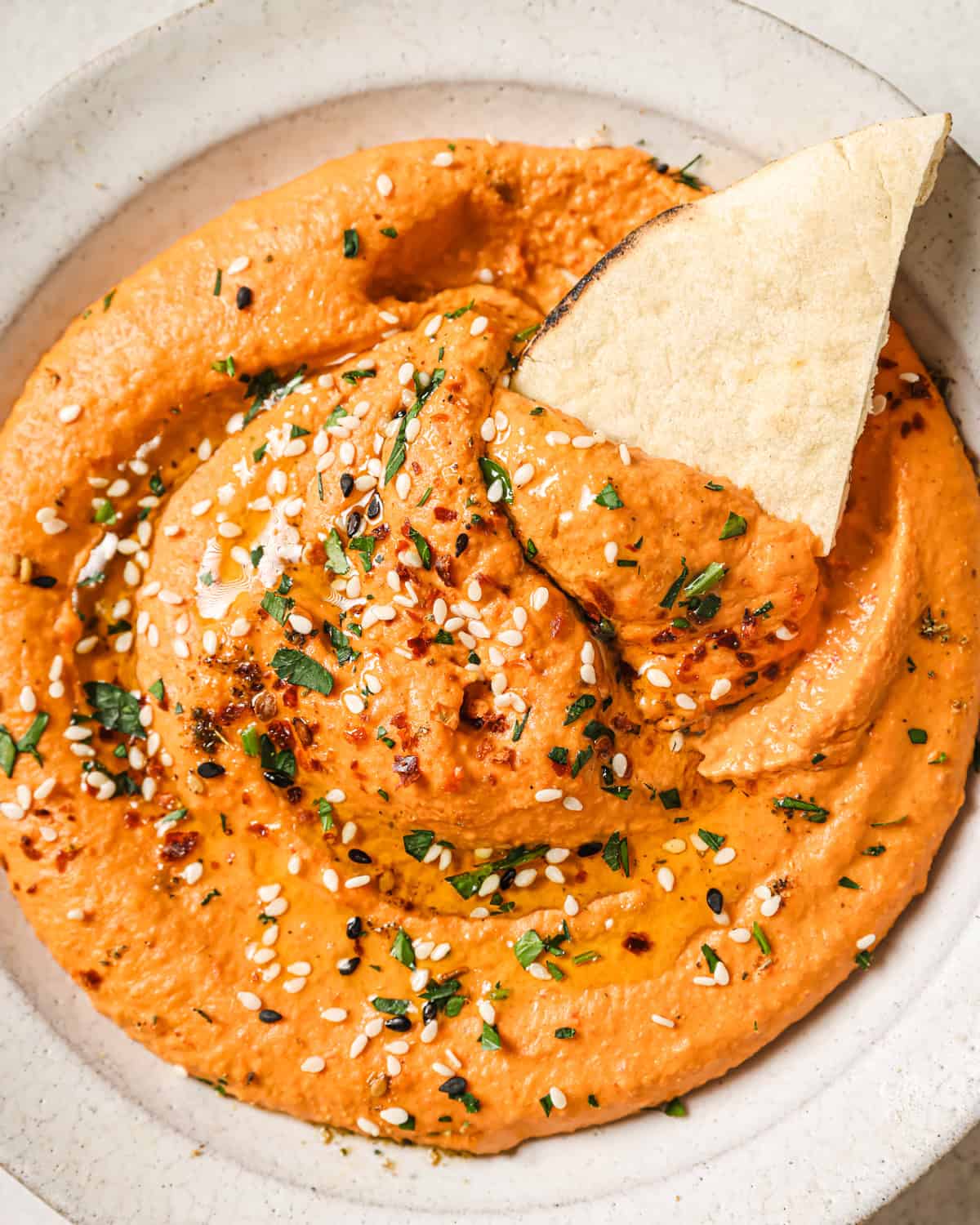This Roasted Red Pepper Hummus will make you break up with store-bought hummus forever. It’s slightly smoky and sweet, tangy, nutty, and creamy—in other words, everything you want in a hummus, plus a little somethin’ extra.
We tested this recipe every which way—dried chickpeas or canned, jarred peppers or freshly roasted—so no matter how much time you’ve got, there’s a version that’ll work for you.
It’s bold in flavor but super simple to make, and incredibly versatile. Serve it as a party dip, use it as a sandwich spread, dollop it on grain bowls, or just keep it in the fridge for snack attacks. However you enjoy it, this hummus brings the flavor. And the fun.
Table of Contents:
1. Why this recipe works
2. Ingredient notes
3. Step-by-step instructions
4. Tips for making this recipe
5. How to serve roasted red pepper hummus
6. Frequently Asked Questions
7. Recipe card with notes
Video: How to make roasted red pepper hummus
Why this recipe works
Big flavor but simple to make
If you’re already in love with my classic hummus (hi, I see you 👀), you’re gonna fall hard for this roasted red pepper twist.
It has the nutty richness of traditional hummus thanks to a generous amount of rich tahini but also the beautiful sweet smokiness of deeply roasted red peppers (which gets nicely amplified by smoked paprika).
Zippy lemon and fresh garlic brighten things up, fruity Aleppo pepper adds a subtle kick, and just a splash of pomegranate molasses add the perfect tang.
Versatile and abundant
Like any hummus, this makes a fabulous party dip alongside pita and crudités, but it’s so much more than that.
Since it makes a LOT of hummus, I love incorporating it into my weekly meal prep. Then I can use the hummus in different meals throughout the week: sandwich spread, grain bowl topper, wrap filler, or as the creamy base for a batch of lentils or beans.
Easy to customize and tweak
We tested this recipe many different ways: with dried chickpeas and canned chickpeas, and with both jarred roasted red peppers and freshly roasted bells.
So no matter your vibe—girl dinner or everything-homemade-energy—we’ve got you covered.
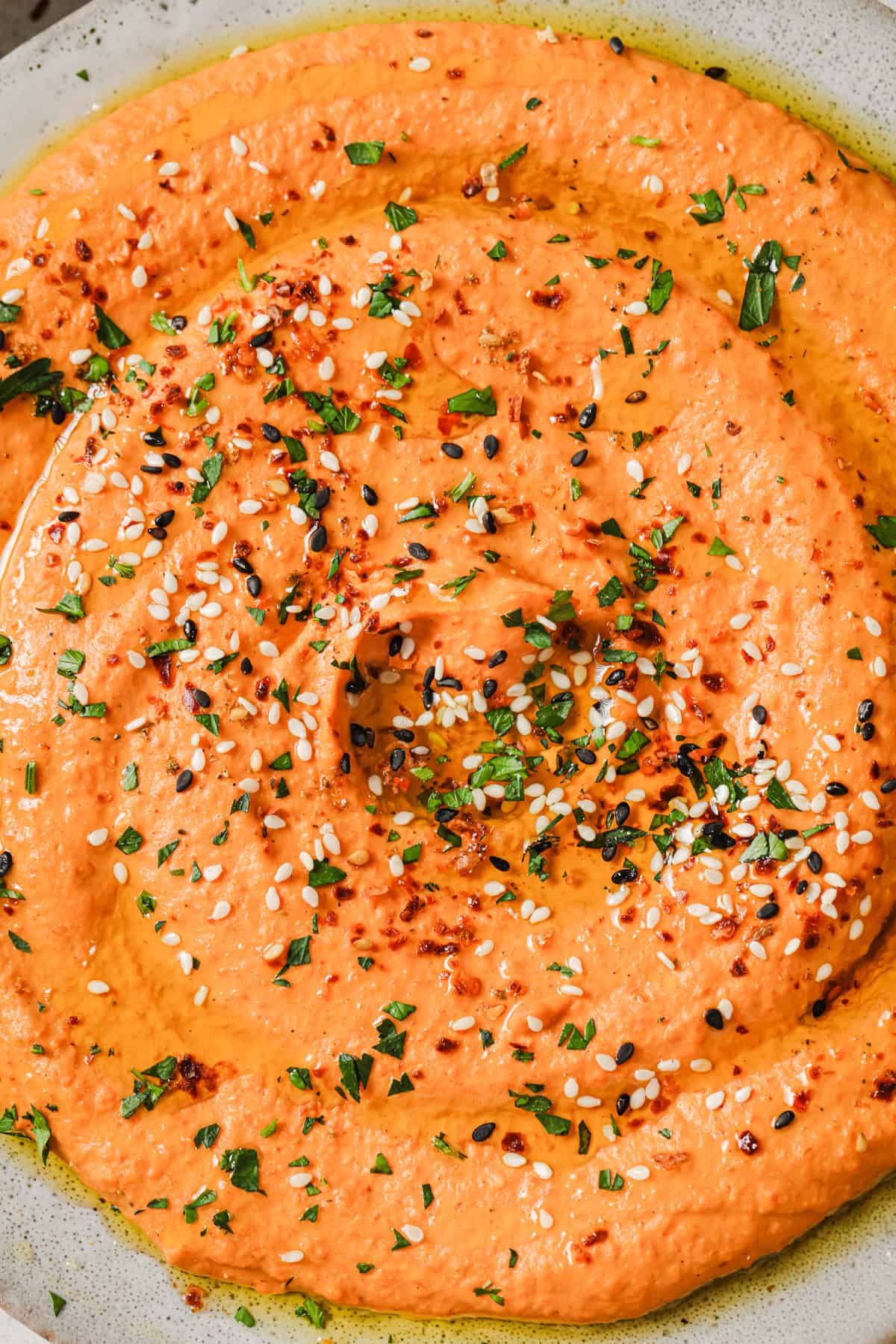
Ingredient notes
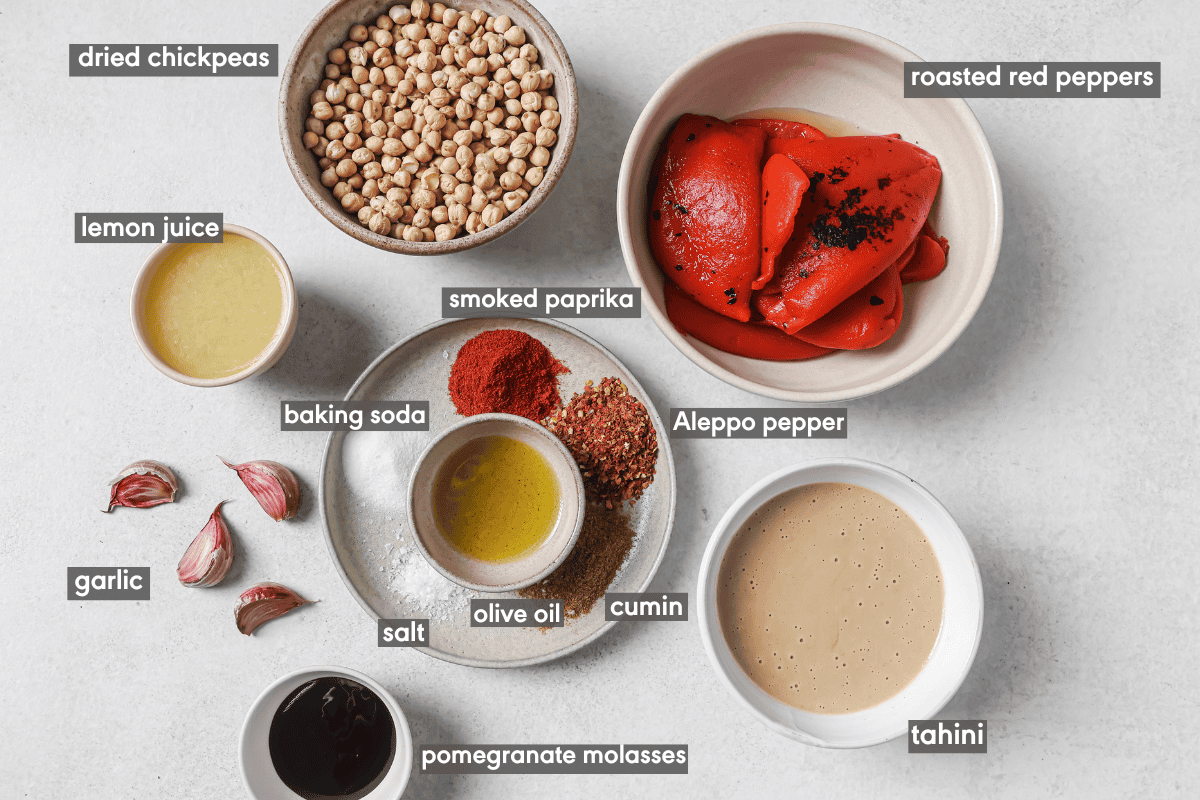
Chickpeas
AKA garbanzo beans. You can use either dried chickpeas or canned chickpeas to make hummus, but for the very best hummus, I prefer to cook dried chickpeas.
Canned chickpeas come with a firmer texture, which can leave the hummus with a slightly chunky texture. Dried chickpeas also have a nuttier, richer flavor.
Don’t have time to cook dried chickpeas? Simply simmer canned chickpeas in boiling water with a pinch of baking soda. This will soften them appropriately. See the FAQ section for more details.
Tahini
Tahini is a smooth and rich paste made from sesame seeds. It’s a primary ingredient in hummus and should never be left out.
Because it’s so essential to hummus, seek out a good-quality tahini, as it makes a huge difference.
Tips for buying: Always use tahini from hulled sesame seeds (unhulled sesame seeds are usually bitter). Lately, I’ve been using Al Kanater tahini. I’ve also used Seed + Mill tahini, Beirut sesame paste, Ziyad, and Soom Foods tahini with good results (affiliate links).
Roasted Red Peppers
For the very best hummus, I suggest roasting fresh red bell peppers from scratch (instructions are in the recipe card).
If you don’t want to roast the peppers yourself, buy a jar of roasted red peppers (I like this brand – affiliate link).
Depending on how much red pepper flavor you like, you’ll want to use a 12-ounce (340g) or 16 ounce (450g) jar of roasted red peppers.
Lemon, Garlic, and Salt
As with my classic hummus, these three ingredients are key. Freshly squeezed lemon juice brightens up the rich, nutty, and savory flavors. Garlic adds a, well, garlicky kick. And salt is necessary to bring out all the other flavors!
Tip: If using sea salt instead of the kosher salt called for in the recipe, you’ll need to use about half of the amount called for in the recipe, then adjust according to your desired taste.
Pomegranate Molasses
The first time I made this red pepper hummus recipe, it was good but it felt a little flat. Usually when that happens, I reach for a source of acid.
But I had already added a generous amount of lemon juice, so I didn’t think that was the solution. I consulted my pantry and then it all made sense. Pomegranate molasses, of course.
A thick syrup made simply from boiled pomegranate juice, it’s a superstar ingredient used in many Middle Eastern and Persian recipes (like muhammara). I adore its unique tart sweetness and use it often in dressings and even salads, like this Quinoa Salad.
Here, it adds that perfect subtly sweet tang that brings everything together.
Tips for buying: Pomegranate molasses is sold online or at Middle Eastern grocers. Look for pure pomegranate molasses made from only 100% pomegranate juice.
I have tried at least half a dozen brands, and the Al Wadi *all natural* version is the best, flavorwise and has a great thick, syrupy texture (affiliate link).
Substitute: If you can’t find this, use a teaspoon of aged balsamic vinegar (this balsamic vinegar is very good quality for its price point – affiliate link).
Step-by-step instructions
If using dried chickpeas: cover the chickpeas in plenty of water with ¼ teaspoon baking soda. Soak overnight or for 8 to 12 hours. Drain and rinse, then add to a medium saucepan with ½ teaspoon baking soda.
Cook the chickpeas, covered, at a rapid simmer for 30 minutes. Uncover, season with salt, and cook for 10 to 20 minutes, or until very soft. Drain.

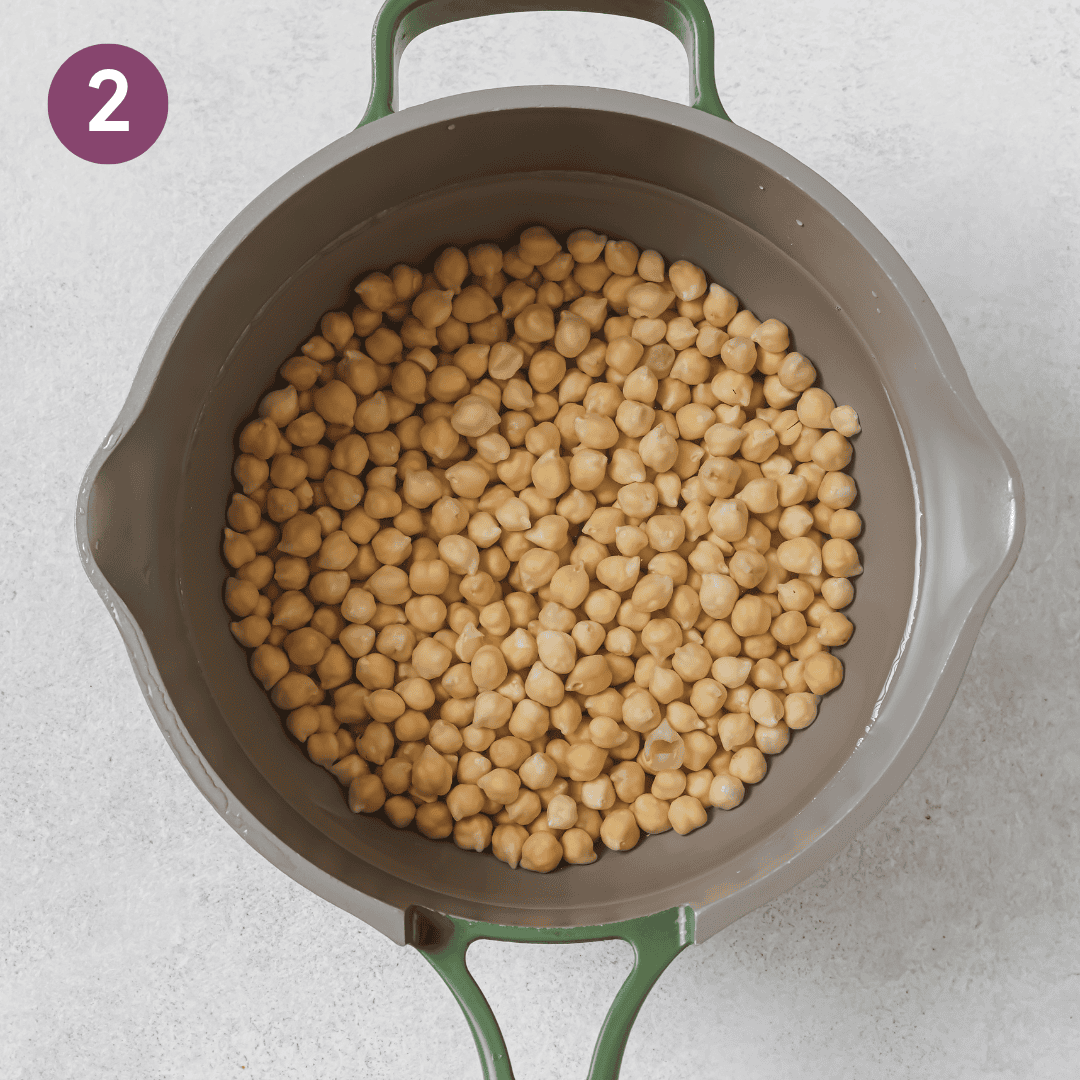
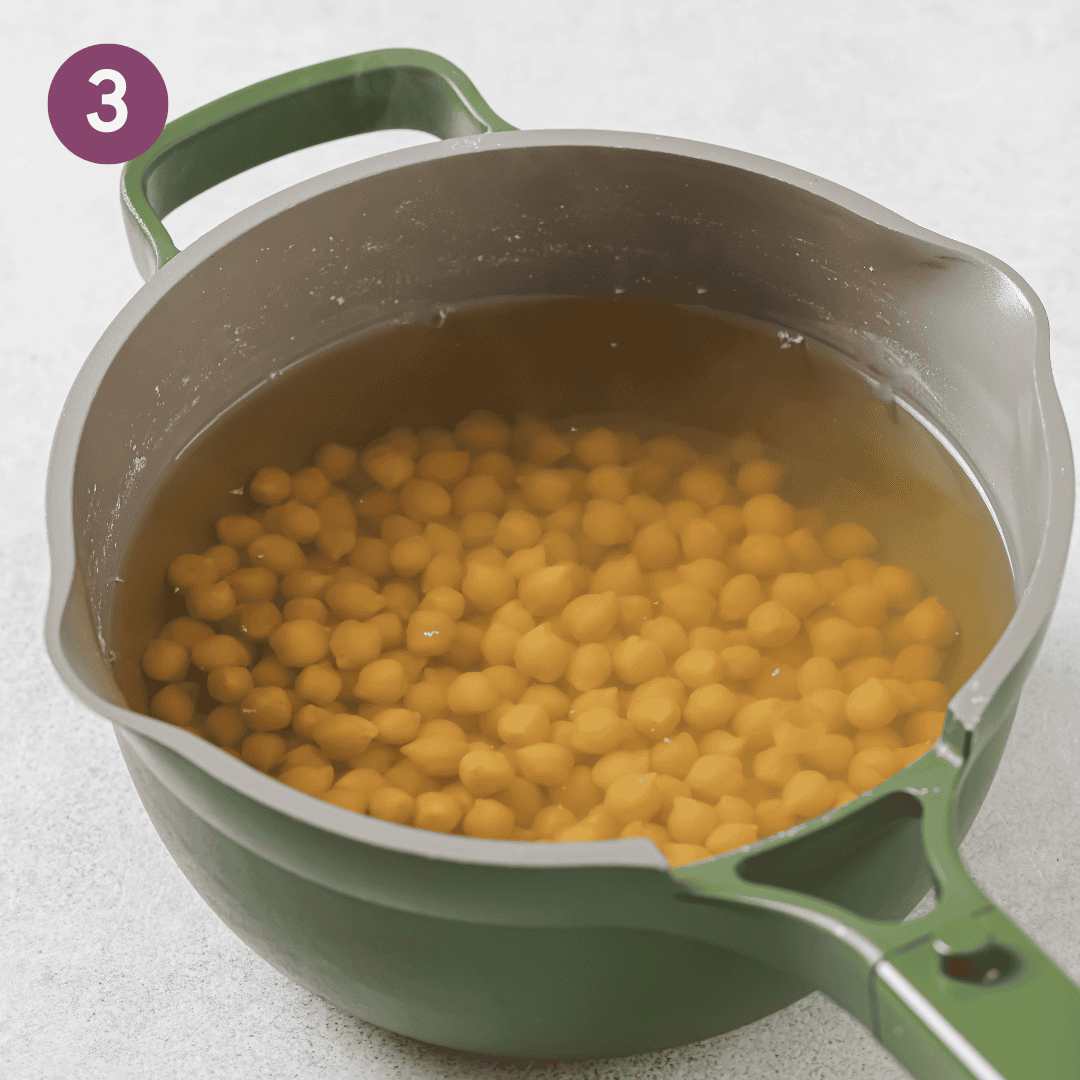
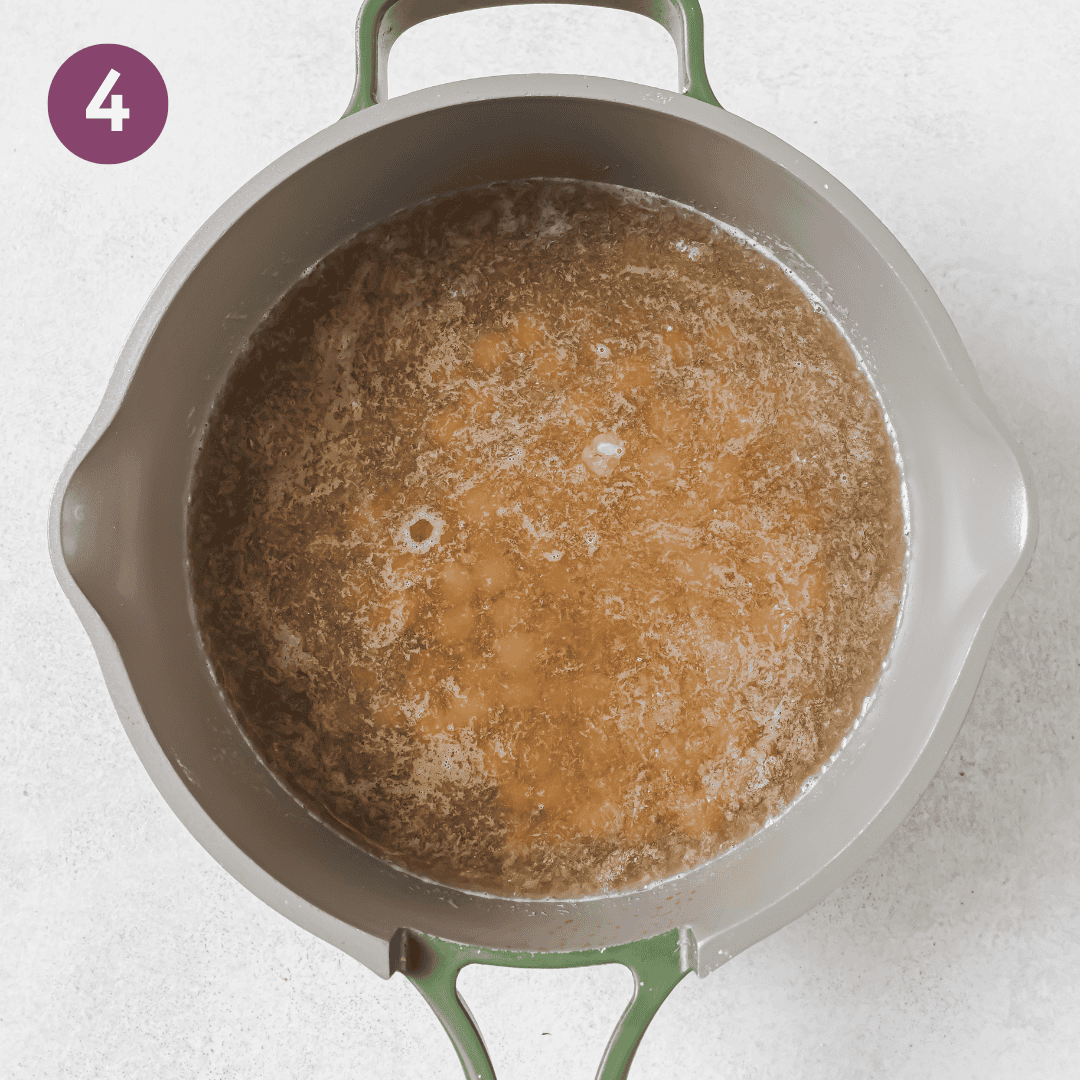
While warm, add the chickpeas to a food processor (or blender).
Blend for a few minutes until a paste forms.
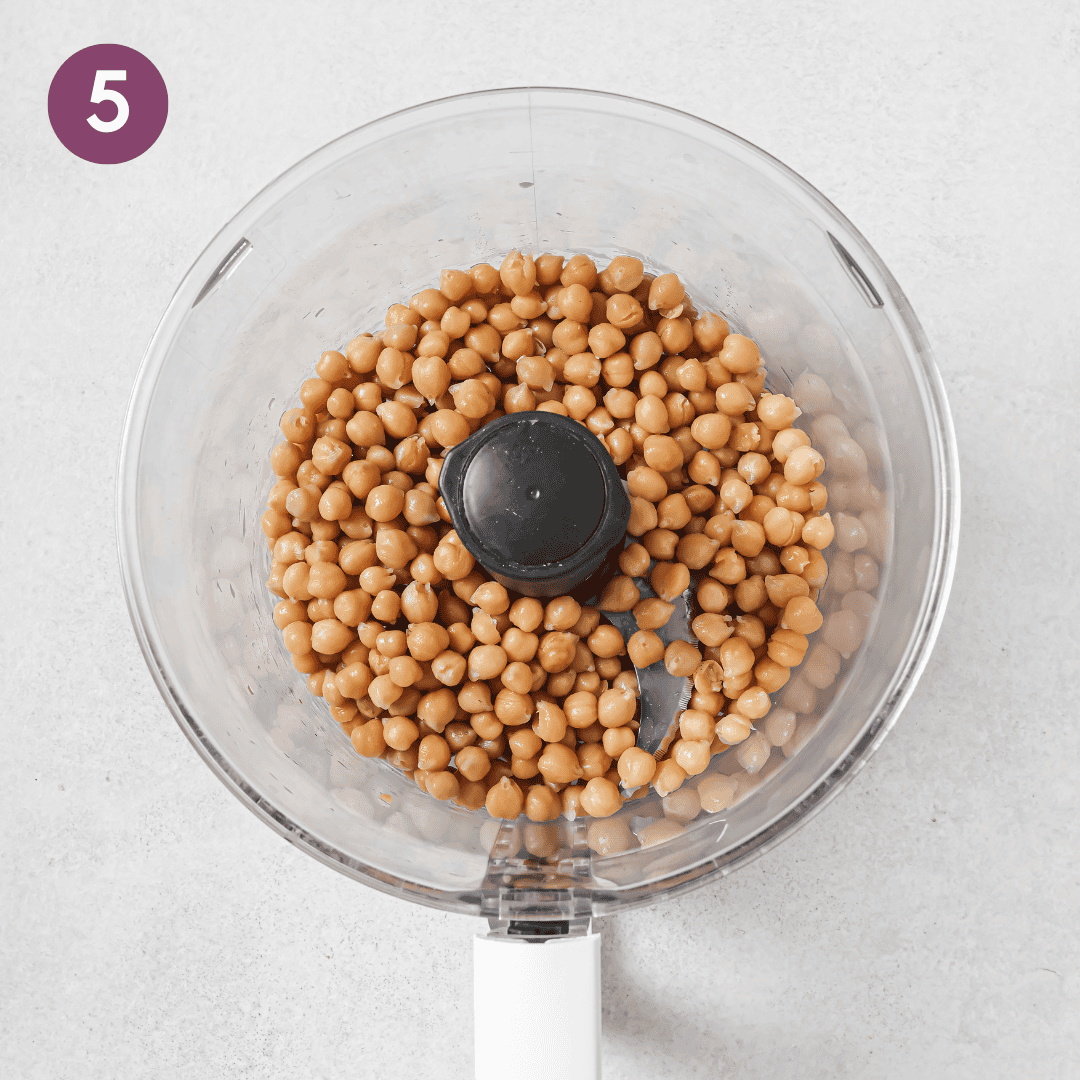
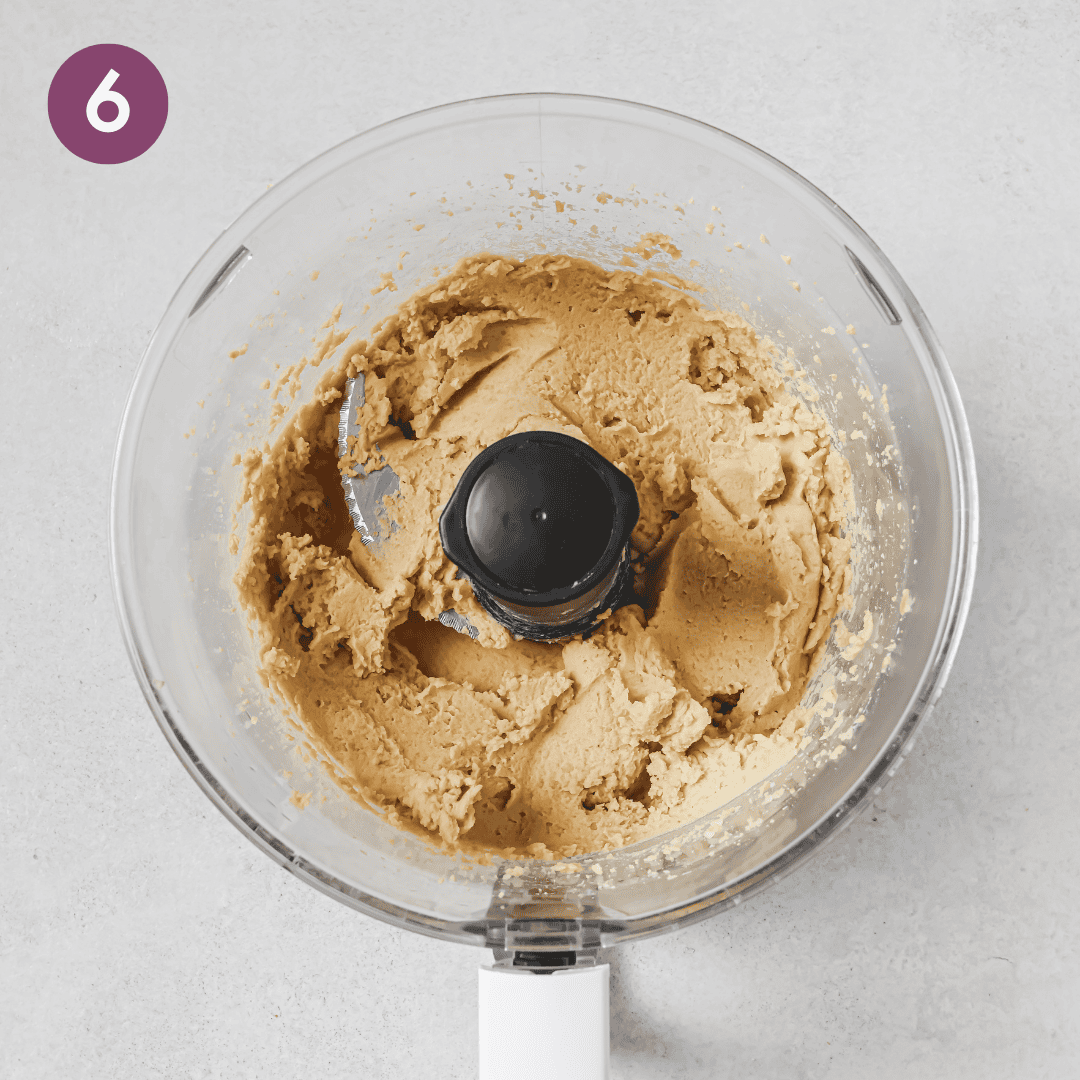
Layer in the remaining ingredients: tahini, garlic, lemon juice, roasted red peppers, spices, salt, olive oil, and pomegranate molasses.
Blend until smooth and creamy, scraping down the sides as you go.
Adjust the seasonings to your taste, adding more salt, lemon, pomegranate molasses, spices, or olive oil as desired.
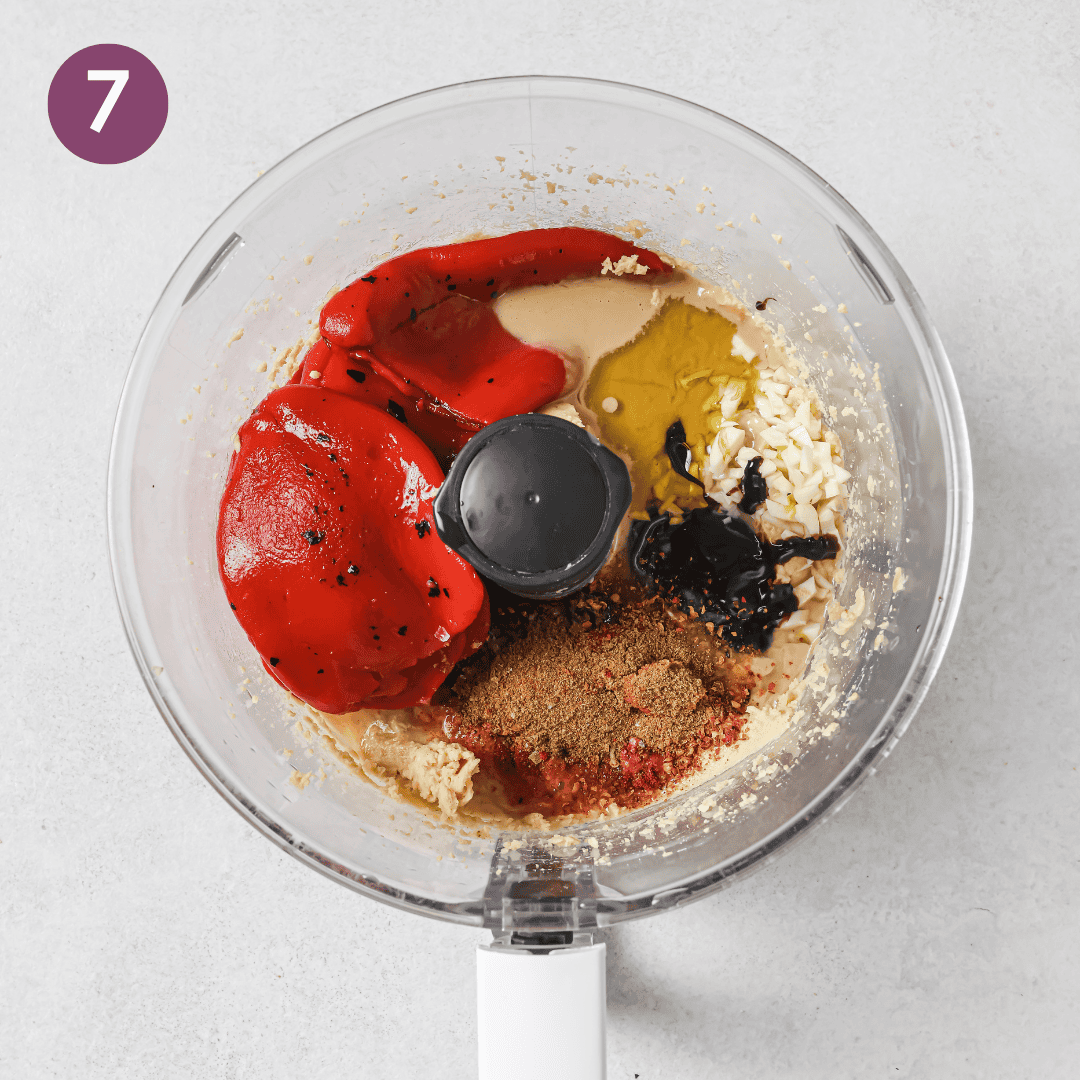
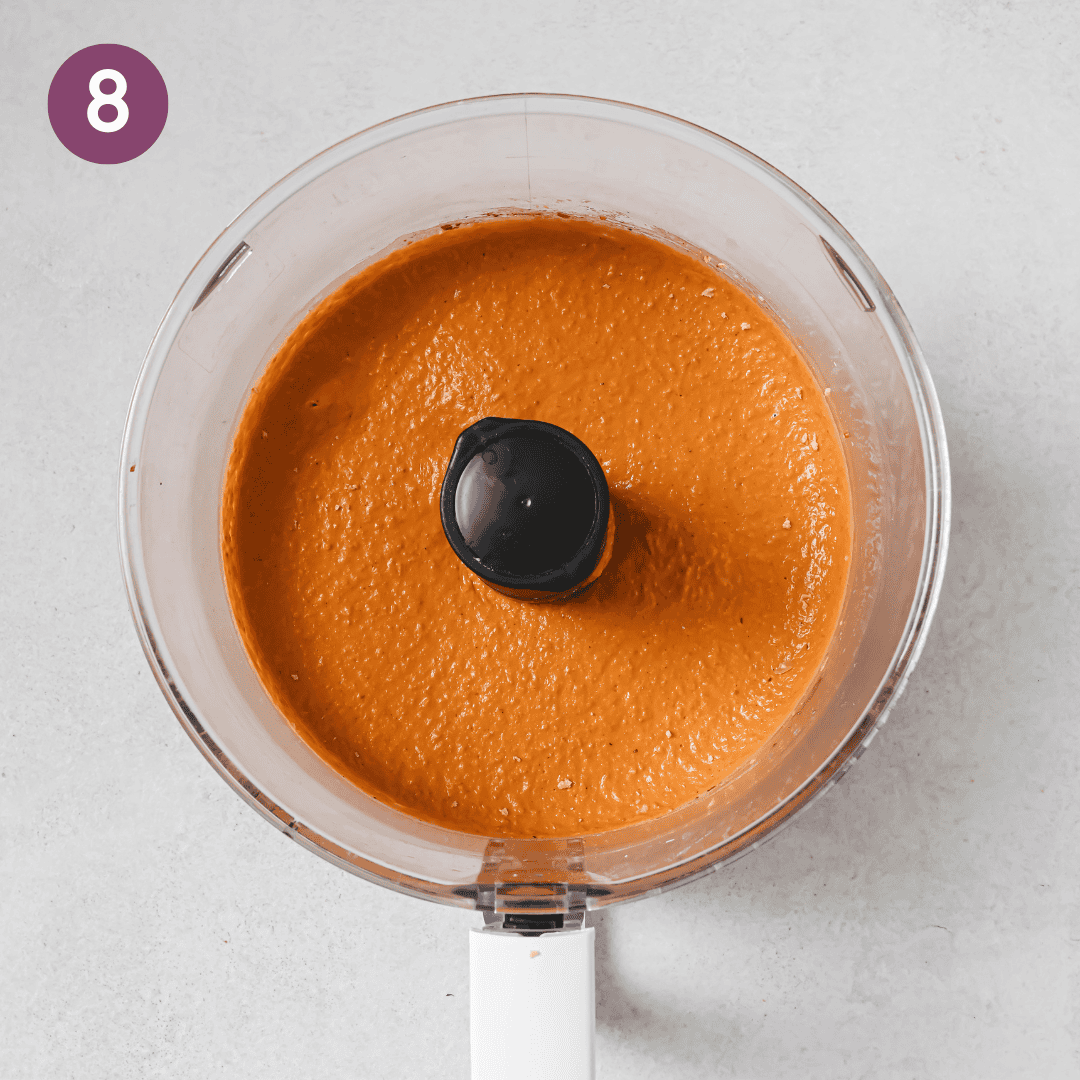
Tips for making this recipe
Pick your preferred combo of roasted peppers and chickpeas
There are four ways to make this recipe:
(1) totally from scratch–cook dried chickpeas and roast fresh red peppers;
(2) partially from scratch, option 1–cook dried chickpeas but use jarred roasted red peppers;
(3) partially from scratch, option 2–use canned chickpeas but roast fresh red peppers; or
(4) sort of from scratch–use canned chickpeas and jarred roasted red peppers.
For the absolute best roasted red pepper hummus, go with option #1.
You’ll get (1) a fresher, slightly sweet flavor from roasting the red peppers yourself and (2) a richer, nuttier flavor and better texture from dried chickpeas.
Plus, roasting fresh peppers is actually much simpler and quicker than you’d think. All you need to do is slice them in half and roast in the oven for ~20 minutes.
If you need to save some time, try to go with option 2 or 3, as you’ll get better flavor over option 4.
The chickpeas should be soft
While al dente chickpeas might be nice in a chickpea salad, for hummus, you want the chickpeas to be very soft.
You want the chickpeas to be easily squashed when pressed between your fingers.
And if using canned chickpeas, it’s important to simmer them first so the hummus gets super smooth. Skipping this step will yield hummus that’s a bit gritty and chunky.
Want the smoothest hummus?
You will achieve the absolute dreamiest texture if you (1) use dried chickpeas and (2) peel the chickpea skins before blending.
But I almost always skip the peeling step because who has the time to individually peel every chickpea skin?
Luckily, when you cook dried chickpeas with baking soda until they’re very soft, a lot of chickpea skins naturally start to loosen. Be sure to discard any loose skins.
A less time-consuming hack for getting ultra smooth hummus? Use a high-powered blender instead of a food processor. It’s less traditional but if smoothness is what you’re after, it’s a reliable technique.
If using a blender, you will need a tamper since there’s very little liquid in the recipe to get things moving.
Not as thick as you’d like?
If you use an entire 16-ounce (450g) jar of roasted red peppers, the hummus may be on the thinner side as soon as it’s done blending.
Not to worry! As this hummus rests, it will naturally thicken.
Serve hummus at room temperature (or warm)
Cold hummus is less delicious for two reasons: (1) it stiffens, so it’s less luxurious in texture; (2) the cold masks all the deliciously complex flavors.
If you’re serving leftover hummus, try to leave it on the counter to come to room temperature, or warm it up a bit (instructions in the FAQ section).
This way, you experience hummus the way it’s intended to be experienced and how it’s typically served across the Middle East—a luxuriously smooth dip with layers of rich, nutty, and savory flavors.
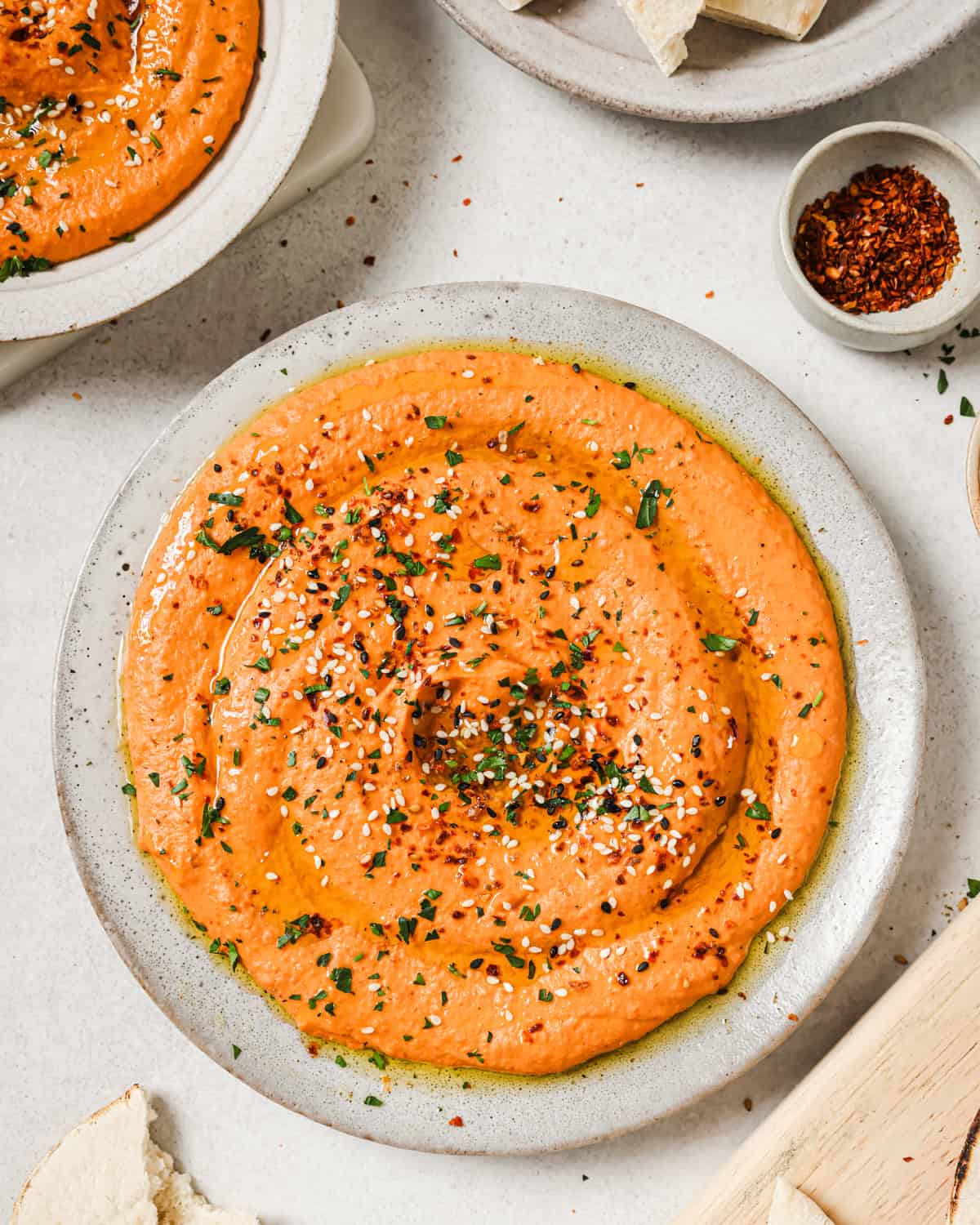
How to serve roasted red pepper hummus
Make it a part of a grazing board, surrounded with pita bread or homemade naan, fresh-cut veggies, crackers, or pita chips for dipping.
Use it as a sandwich spread. I love this hummus on sourdough with pan-fried tofu slabs, broccoli sprouts, pickled onions, crunchy lettuce, and sliced cucumbers.
Make it part of your mezze platter. Any kind of hummus–whether red pepper hummus, beet hummus, or classic hummus–belongs on a mezze platter. Round it out with other dips, like tzatziki, and serve with small plates of marinated olives, pickled veggies, crudités, crackers, and crostini.
Use it in wraps. Slather it onto a wrap, top with white beans or lentils, add lightly dressed arugula or salad greens of choice, vegan feta, sprinkle on some hemp seeds for extra protein, and roll up.
In the Middle East, you’ll find hummus included as part of the main or side dishes during breakfast, lunch, and dinner. I like to use this hummus as the base layer on a plate, then top with cooked lentils and roasted veggies or fresh salads.
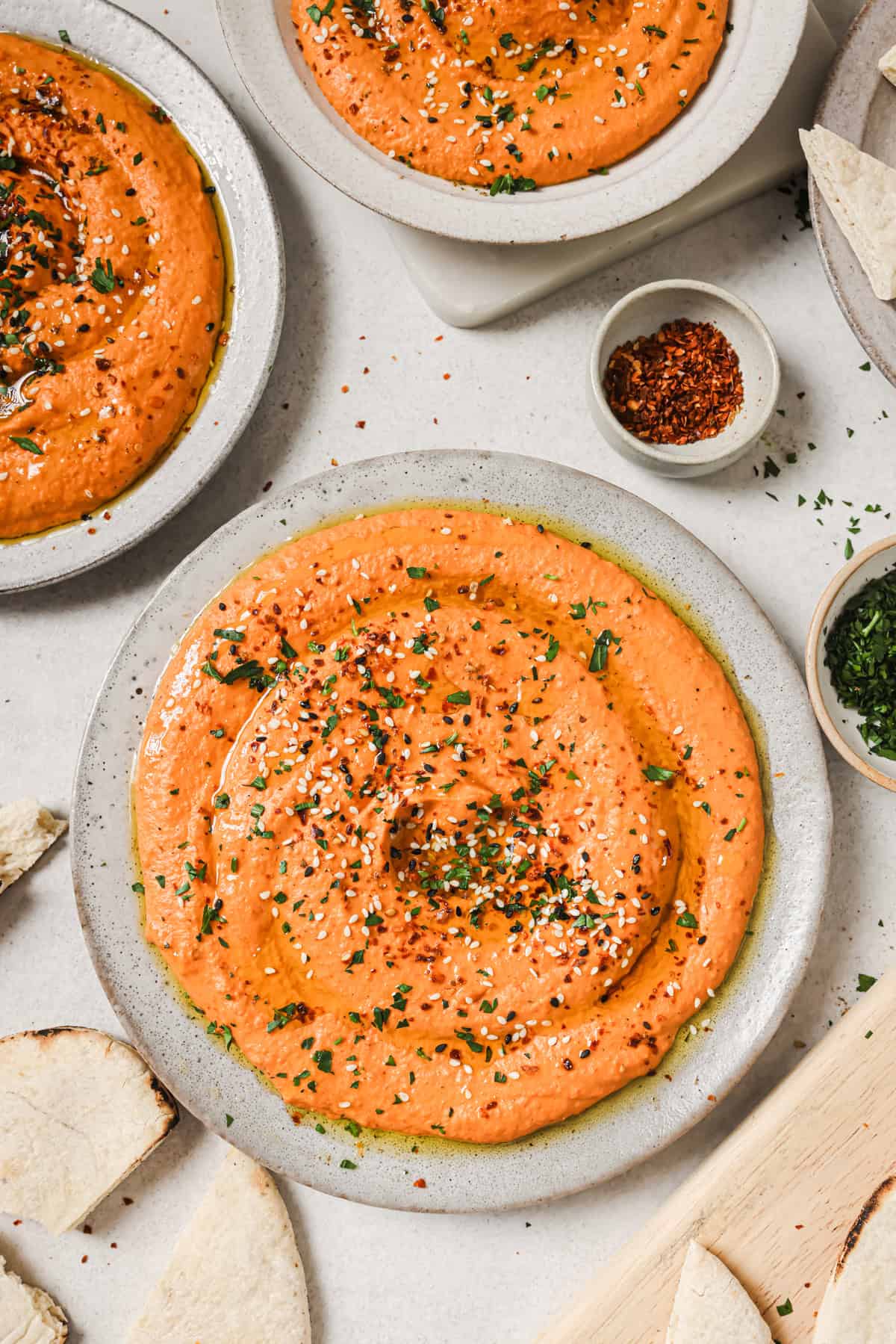
Frequently Asked Questions
Yes, though the results won’t be quite as good as if you cook dried chickpeas.
In this recipe, you can substitute the dried chickpeas with 2 (15-ounce/425g) drained and rinsed cans. For a stronger roasted red pepper flavor, use 1 ½ cans.
Since canned chickpeas are rather firm, I strongly recommend simmering the canned chickpeas (even though they’re already cooked).
Add them to a saucepan, cover with an inch or two of water, and add ¼ teaspoon baking soda. Bring to a boil over high heat, then reduce the heat to maintain a rapid simmer for 20 minutes, or until the chickpeas start falling apart. Continue making the recipe as per the instructions at step 3 (draining the chickpeas and adding them to the food processor.
Yes. A high-powered blender will yield the smoothest hummus.
However, it needs to be a high-powered blender, and you need to have a tamper since there’s very little liquid in this recipe.
If you don’t have pomegranate molasses, use 1 teaspoon of aged balsamic vinegar. Taste, adding more as desired. If more tang is desired, add more lemon juice.
If you don’t have Aleppo pepper, omit it, or use ½ teaspoon red pepper flakes if you want a spicy kick.
Allow it to sit at room temperature, or warm it up. Warming it up loosens the texture, making it smoother.
Simply add the amount of hummus you’d like to reheat to a saucepan, add a couple teaspoons of water, and stir constantly for a few minutes until warmed through. Or, heat it in the microwave in 10-second increments, stirring after each round.
It will stay fresh for 5 to 7 days in the fridge.
You can freeze hummus, though you’ll lose some of that irresistible texture.
To freeze, transfer the hummus to an airtight container but leave some room at the top to allow for expansion. Thaw it in the fridge the day before consuming.
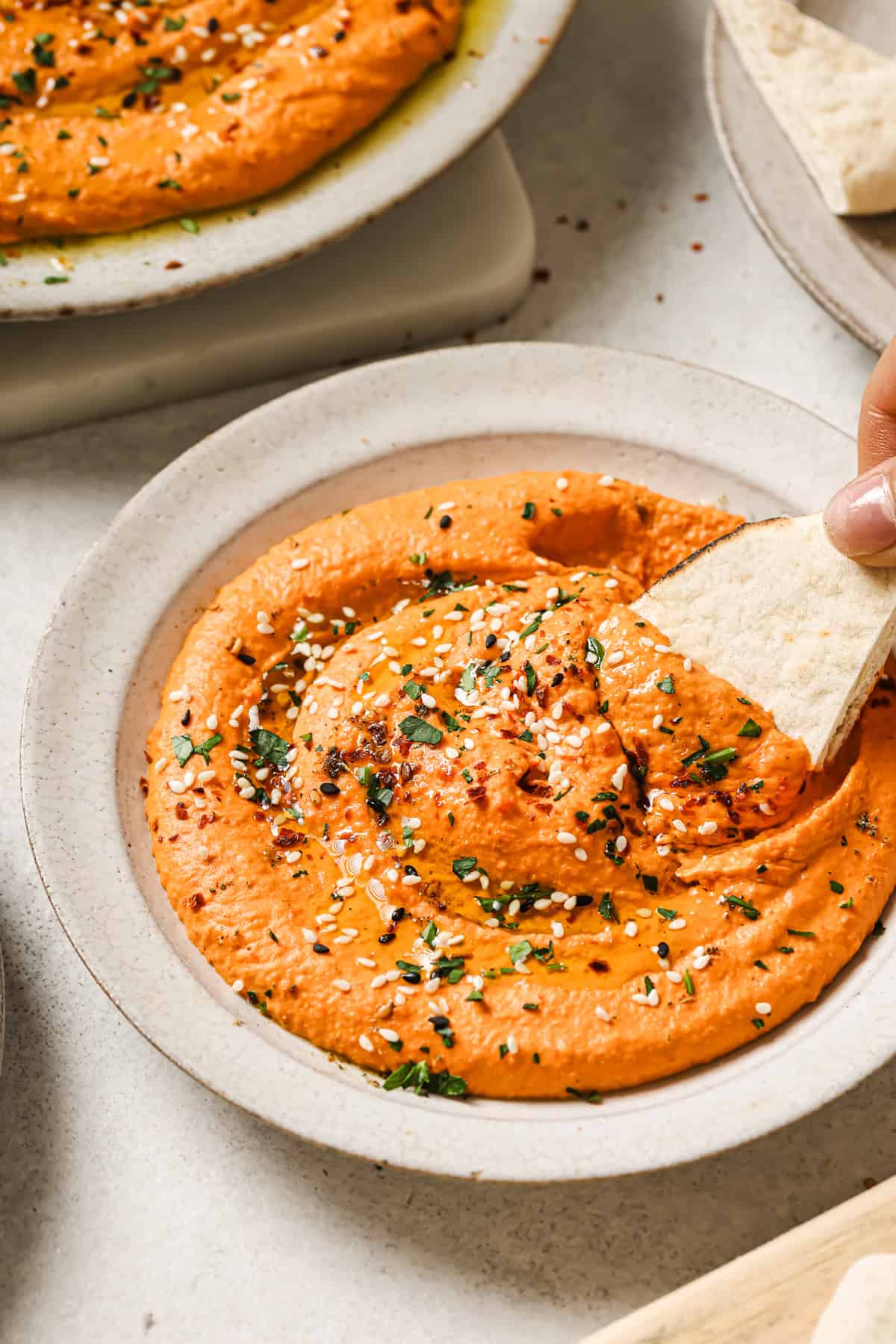

Big Vegan Flavor
Techniques and 150 recipes to master vegan cooking.
Roasted Red Pepper Hummus
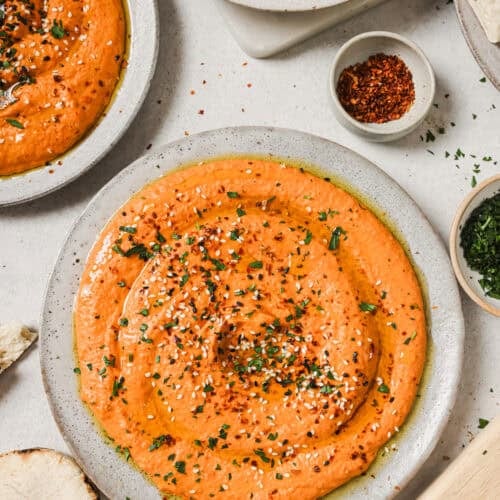
This Roasted Red Pepper Hummus is everything you love about classic hummus, but with a smoky, slightly sweet twist. Whether you go all from-scratch or opt for a shortcut with jarred peppers and canned chickpeas, you’ll get a crowd-pleasing dip that’s anything but ordinary.
-
Soak the chickpeas. Add the chickpeas to a large bowl. Cover with cold water and ¼ teaspoon baking soda. Soak for 8 hours or overnight. Drain and rinse.
-
Cook the chickpeas. Add the drained chickpeas to a medium saucepan with ½ teaspoon baking soda and 5 cups (1.2 L) water. Bring to a boil over medium-high heat. Use a metal spoon to skim off any thick foam. Cover and reduce the heat to low or medium-low to maintain a rapid simmer; cook for 30 minutes.Uncover the pot and add 1 teaspoon of kosher salt. Cook uncovered for 10 to 20 minutes, or until the chickpeas are very soft and easily smush when pressed between your fingers. Drain well.
-
While the chickpeas cook, prepare the red peppers.For jarred peppers, drain the peppers and pat them dry very well, then tear into strips (I don’t rinse them since it removes some of the smoky flavor).
-
If roasting fresh peppers: Arrange a rack in the top third of the oven. Preheat the oven to 450ºF/230ºC. Line a rimmed sheet pan with parchment paper.Cut the red bell peppers in half, lengthwise. Remove seeds, membranes, and stem. Arrange peppers on the lined pan, cut side down.Roast for 12 to 15 minutes, then rotate the pan 180º. Roast for 8 to 10 minutes, or until the top skins are charred and peppers have softened.Add peppers to a bowl and cover tightly with plastic wrap. Steam for 10 minutes, then peel the skins. Discard skins & any accumulated liquid. Tear the peppers into strips.
-
While still warm, transfer the cooked chickpeas to a food processor. Blend for 1 to 2 minutes until you have a smooth paste, scraping down the sides as you go.
-
To the food processor, add the tahini, lemon juice, garlic, and olive oil. Blend for a minute or two, scraping down the sides as you go, until well incorporated and as smooth as possible. It will be very thick at this point.
-
Add the roasted peppers, cumin, smoked paprika, Aleppo pepper, 1 teaspoon kosher salt, and the pomegranate molasses.NOTE: If your fresh red peppers are very sweet, you may want to start with 2 teaspoons pomegranate molasses.
-
Blend again until smooth and well incorporated, scraping down the sides as you go. Taste, adding more salt, smoked paprika for smokiness, Aleppo pepper for mild heat, or lemon juice for tang.NOTE: If using jarred peppers, the texture may be on the thinner side, but it will thicken as it rests in the fridge. Also, the flavors will develop more as the hummus rests.
-
To serve: Transfer the hummus to a shallow bowl and use the back of a spoon to make waves or to make a well in the center. Drizzle good-quality olive oil on top. Top with chopped parsley and a few sprinkles of Aleppo pepper.
- This recipe is best with dried chickpeas, but if using canned chickpeas, drain and rinse 2 (15 oz/425g) cans of chickpeas (or, for a stronger roasted red pepper flavor, use 1 ½ cans). Add them to a medium saucepan with ¼ teaspoon baking soda; cover with an inch or two of water. Bring to a boil, then reduce the heat to maintain a rapid simmer for 20 minutes, or until the chickpeas start falling apart. Drain and rinse again.
- For the absolute best flavor, roast whole bell peppers from scratch; see Step 4. If using jarred peppers, a 16 oz jar, once drained, yields about 10 to 11 oz (300g) of roasted peppers, or 4 whole peppers.
- You can buy this at spice shops, Middle Eastern grocers, or online (affiliate link). If you don’t have Aleppo pepper, use ¼ to ½ teaspoon red pepper flakes, or to taste.
- You can buy this online or at Middle Eastern grocers. I used this brand and also love this one (affiliate link). If you don’t have pomegranate molasses, use 1 teaspoon of aged balsamic vinegar. Taste, adding more as desired. For more tang, add more lemon juice.
#Roasted #Red #Pepper #Hummus
Image Source : rainbowplantlife.com
